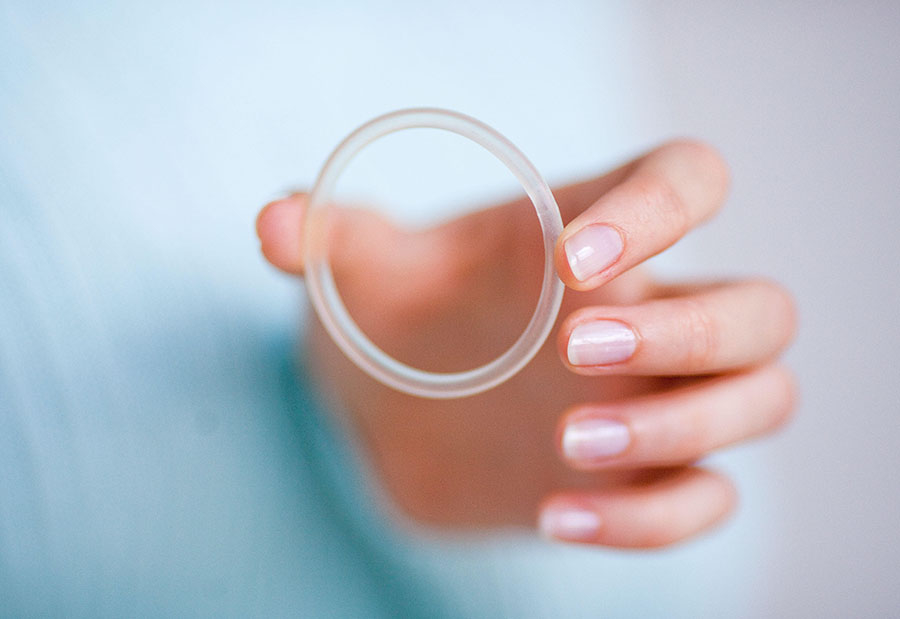What is the contraceptive vaginal ring?
The vaginal ring is a form of contraception (birth control). It’s a soft plastic ring that you put into your vagina. It releases the same hormones as the contraceptive pill to prevent pregnancy.
The vaginal ring can also help control your periods. It’s sometimes called a ‘birth control ring’.
NuvaRing is the only type of vaginal ring available in Australia. You need a prescription from your doctor to get the vaginal ring.

How does the vaginal ring work?
The vaginal ring releases the hormones oestrogen and progestogen. These hormones are absorbed through the walls of the vagina. They are the same hormones used in the combined oral contraceptive pill.
The hormones stop pregnancy by:
- stopping your ovaries from releasing eggs
- thickening the mucus at the entrance to the uterus (womb)
How do I use the vaginal ring?
You can insert and remove the vaginal ring yourself.
The ring should be put in at the correct time during your menstrual cycle. Your doctor can help you work out when to start using the ring.
Once inserted properly, the ring sits high in your vagina. It’s left in place for 3 weeks to release the hormones. Most people can’t feel it. Don’t remove the ring during sex or exercise — it should be left in place.
After 3 weeks, you should take out the ring. You should have 7 days without a ring, and then put in a new vaginal ring. During the week with no ring you will have a bleed like a period.
If your ring accidentally comes out, rinse it with water and put it back in straight away.
How well does the vaginal ring work at preventing pregnancy?
The vaginal ring works well at preventing pregnancy when used properly. With typical use, 7 in 100 people will become pregnant when using a vaginal ring.
The ring won’t work if you forget to put it in and take it out at the right times. If you put in or take out your ring too early or late:
- read the instructions that come with your ring on what to do
- talk to your doctor or family planning clinic
If you have not used your vaginal ring as directed, you may need to use another type of contraception (such as condoms) for 7 days. If you have had unprotected sex during this time, you might consider taking emergency contraception. This is available from your doctor, pharmacist, or family planning clinic.
Some medicines for epilepsy and some herbal preparations can stop the vaginal ring from working properly. Talk to your doctor before starting any new medicines or supplements while you’re using the vaginal ring.
Can the vaginal ring help control my periods?
The vaginal ring can help control your periods and other symptoms. It can:
- make your bleeding regular and lighter
- reduce period pain
- improve premenstrual syndrome (PMS)
- improve acne
If you don’t want to have a period, you can talk to your doctor about putting a new ring in straight after the old one.
What are the advantages and disadvantages of the vaginal ring?
Advantages of the vaginal ring:
- It doesn’t need to be fitted by a doctor — you can put it in yourself.
- Unlike the pill, you don’t need to take it every day and it’s not affected by vomiting or diarrhoea.
- The vaginal ring can help control your periods.
- Breakthrough bleeding is less frequent with the vaginal ring compared with the pill.
- It allows your fertility to return quickly when the ring is removed.
Disadvantages of the vaginal ring:
- You need to remember to place and remove the vaginal ring at the right times.
- It may be uncomfortable or accidentally come out.
- It can cause similar side effects to the pill, such as headache, nausea, bloating, tender breasts, acne, mood changes, loss of interest in sex, breakthrough bleeding and brown patches on the face.
- The vaginal ring can be more expensive than the pill.
- There is a small risk of blood clots (or thrombosis), heart attack and stroke associated with using the vaginal ring.
- The vaginal ring can’t protect you against sexually transmitted infections (STIs).
Who should not use a vaginal ring?
The vaginal ring is not recommended if you:
- are older than 35 years and smoke
- have had a baby in the last 6 weeks
- have ever had a deep vein thrombosis, heart attack or stroke
- have certain types of heart disease
- have a condition that increases your risk of blood clots
- have severe liver problems
- have other conditions, including some types of migraine, breast cancer or some types of lupus
Talk to your doctor or family planning clinic about whether the vaginal ring would be suitable for you.


